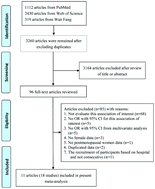当前位置:
X-MOL 学术
›
Food Funct.
›
论文详情
Our official English website, www.x-mol.net, welcomes your
feedback! (Note: you will need to create a separate account there.)
Fruit and vegetable consumption and the risk of postmenopausal osteoporosis: a meta-analysis of observational studies†
Food & Function ( IF 5.1 ) Pub Date : 2018-04-18 00:00:00 , DOI: 10.1039/c8fo00205c Danqing Hu 1, 2, 3, 4, 5 , Lixiao Cheng 1, 2, 3, 4, 5 , Wenjie Jiang 1, 2, 3, 4, 5
Food & Function ( IF 5.1 ) Pub Date : 2018-04-18 00:00:00 , DOI: 10.1039/c8fo00205c Danqing Hu 1, 2, 3, 4, 5 , Lixiao Cheng 1, 2, 3, 4, 5 , Wenjie Jiang 1, 2, 3, 4, 5
Affiliation

|
The association of the consumption of fruit and vegetables (FV) and the risk of postmenopausal osteoporosis (PMOP) has been a controversial subject. Thus, we carried out a meta-analysis to evaluate the association of FV consumption and the risk of PMOP. PubMed, Web of Science and Wan Fang were searched for relevant articles published up to March 2018. To evaluate the association of FV intake and PMOP risk, combined odds ratio (OR) and 95% confidence intervals (CIs) were calculated with the fixed or random effects model. Eighteen studies involving 12 643 participants were included in this meta-analysis. When comparing the highest with the lowest consumption, the pooled OR of PMOP was 0.68 (95% CI, 0.56–0.83; I2 = 57.3%; REM) for fruit and 0.87 (95% CI, 0.65–1.16; I2 = 68.9%; REM) for vegetables. For the intake of fruit and the risk of PMOP, subgroup analysis showed a significant association in case-control studies (OR, 0.52; 95% CI, 0.35–0.77; I2 = 3.1%; FEM) and cross-sectional studies (OR, 0.73; 95% CI, 0.59–0.89; I2 = 61.1%; REM). For the intake of vegetables and the risk of PMOP, subgroup analysis showed a significant association in case-control studies (OR, 0.62; 95% CI, 0.42–0.90; I2 = 0.0%; FEM) but not in cross-sectional studies (OR, 0.95; 95% CI, 0.69–1.29; I2 = 68.9%; REM). This meta-analysis indicates that fruit intake might be beneficial for the prevention of osteoporosis in postmenopausal women. The findings need to be confirmed by further investigations.
中文翻译:

食用水果和蔬菜以及绝经后骨质疏松症的风险:一项观察性研究的荟萃分析†
食用水果和蔬菜(FV)与绝经后骨质疏松症(PMOP)的风险之间的关系一直是一个有争议的主题。因此,我们进行了荟萃分析,以评估FV消费与PMOP风险之间的关系。搜索PubMed,Web of Science和Wan Fang以查找截至2018年3月的相关文章。为了评估FV摄入量与PMOP风险之间的关系,采用固定或无效的方法计算组合比值比(OR)和95%置信区间(CIs)。随机效应模型。这项荟萃分析包括18项研究,涉及12 643名参与者。比较最高和最低消耗量时,水果的PMOP合并OR为0.68(95%CI,0.56-0.83; I 2 = 57.3%; REM)和0.87(95%CI,0.65-1.16; I 2= 68.9%;REM)用于蔬菜。对于水果的摄入和发生PMOP的风险,亚组分析显示,病例对照研究(OR为0.52; 95%CI为0.35-0.77;I 2 = 3.1%; FEM)与横断面研究(OR为显着相关) ,0.73; 95%CI,0.59-0.89;I 2 = 61.1%; REM)。对于蔬菜的摄入量和PMOP的风险,亚组分析显示在病例对照研究中存在显着相关性(OR,0.62; 95%CI,0.42-0.90;I 2 = 0.0%; FEM),但在横断面研究中却没有(OR,0.95; 95%CI,0.69–1.29;I 2= 68.9%;REM)。这项荟萃分析表明,摄入水果对于预防绝经后妇女的骨质疏松症可能是有益的。调查结果需要进一步调查确认。
更新日期:2018-04-18
中文翻译:

食用水果和蔬菜以及绝经后骨质疏松症的风险:一项观察性研究的荟萃分析†
食用水果和蔬菜(FV)与绝经后骨质疏松症(PMOP)的风险之间的关系一直是一个有争议的主题。因此,我们进行了荟萃分析,以评估FV消费与PMOP风险之间的关系。搜索PubMed,Web of Science和Wan Fang以查找截至2018年3月的相关文章。为了评估FV摄入量与PMOP风险之间的关系,采用固定或无效的方法计算组合比值比(OR)和95%置信区间(CIs)。随机效应模型。这项荟萃分析包括18项研究,涉及12 643名参与者。比较最高和最低消耗量时,水果的PMOP合并OR为0.68(95%CI,0.56-0.83; I 2 = 57.3%; REM)和0.87(95%CI,0.65-1.16; I 2= 68.9%;REM)用于蔬菜。对于水果的摄入和发生PMOP的风险,亚组分析显示,病例对照研究(OR为0.52; 95%CI为0.35-0.77;I 2 = 3.1%; FEM)与横断面研究(OR为显着相关) ,0.73; 95%CI,0.59-0.89;I 2 = 61.1%; REM)。对于蔬菜的摄入量和PMOP的风险,亚组分析显示在病例对照研究中存在显着相关性(OR,0.62; 95%CI,0.42-0.90;I 2 = 0.0%; FEM),但在横断面研究中却没有(OR,0.95; 95%CI,0.69–1.29;I 2= 68.9%;REM)。这项荟萃分析表明,摄入水果对于预防绝经后妇女的骨质疏松症可能是有益的。调查结果需要进一步调查确认。











































 京公网安备 11010802027423号
京公网安备 11010802027423号